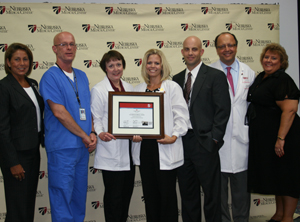 |
From left: Deb Istas, neurological science service line director at The Nebraska Medical Center; Ray Dial, manager of inpatient neuro unit; Karen Bever, stroke center case manager; Denise Gorski, stroke center case manager; William Thorell, M.D., associate professor of neurosurgery at UNMC; Pierre Fayad, M.D., Reynolds Centennial Professor and chairman of neurology; and Amy Wood of the American Heart Association. |
The Nebraska Medical Center received the Gold (Sustained) Performance Achievement Award for its performance in treating stroke patients using the program. Last year, the medical center received the Silver Award.
The Nebraska Medical Center is one of 53 hospitals being recognized with the Gold (Sustained) Performance Achievement Award for stroke care by the American Heart Association/American Stroke Association GWTG program in an advertisement in the July 21 “America’s Best Hospitals” issue of U.S.News & World Report.
GWTG is a hospital-based, quality-improvement program designed to ensure that hospitals consistently care for cardiac and stroke patients following the most up-to-date guidelines and recommendations. The program provides three modules that address coronary artery disease, heart failure and stroke. Currently more than 1,450 hospitals use one or more GWTG modules.
Hospitals receiving the GWTG Gold (Sustained) Performance Achievement Award for stroke care have reached an aggressive goal of treating stroke patients with 85 percent or higher compliance to core standard levels of care as outlined by the association for 24 consecutive months.
“This accomplishment signifies that The Nebraska Medical Center has consistently committed to and successfully implemented accepted standards, or guidelines, to improve quality patient care by turning guidelines into lifelines,” said Pierre Fayad, M.D., Reynolds Centennial Professor and chairman of neurological sciences at UNMC and director of the Stroke Center at The Nebraska Medical Center. “Rapid assessment, treatment and intensive acute care is vital for stroke patients to help them gain back as much of their lives as possible and prevent complications.”
The American Heart Association/American Stroke Association’s advertisement recognizes The Nebraska Medical Center’s commitment and success in performance achievement.
|
|
Dr. Fayad said that the GWTG program addresses the important element of time.
“With a stroke, time lost is brain lost,” Dr. Fayad said.
The Nebraska Medical Center has developed a comprehensive system for rapid diagnosis and treatment of stroke patients admitted through the emergency department or transferred from other hospitals. The medical center ensures the prompt availability and coordination of medical professionals, personnel and equipment 24 hours a day, seven days a week.
Highlights of its expertise include:
- Rapid brain and blood vessel imaging;
- Neurologists;
- Neurosurgeons;
- Emergency physicians;
- Radiologists and pharmacists available to conduct acute patient evaluations; and
- Use of clot-busting medications and interventional clot removal techniques when appropriate.
Get With the Guidelines also helps ensure that the patients treated and discharged receive quality care in accordance with guidelines to reduce the risk of a second stroke. Patients who have had a stroke are at highest risk for another stroke. According to the American Heart Association/American Stroke Association, each year about 700,000 people suffer a stroke; 200,000 of which are second strokes.
But studies show that patients who are taught how to manage their risk factors while still in the hospital reduce their risk of a second stroke.
The stroke center at The Nebraska Medical Center has also achieved recognitions from other organizations. The Nebraska Medical Center was Nebraska’s first and Omaha’s only stroke center to receive the “Gold Seal of Approval” from the Joint Commission for its dedication to the prevention and management of stroke.